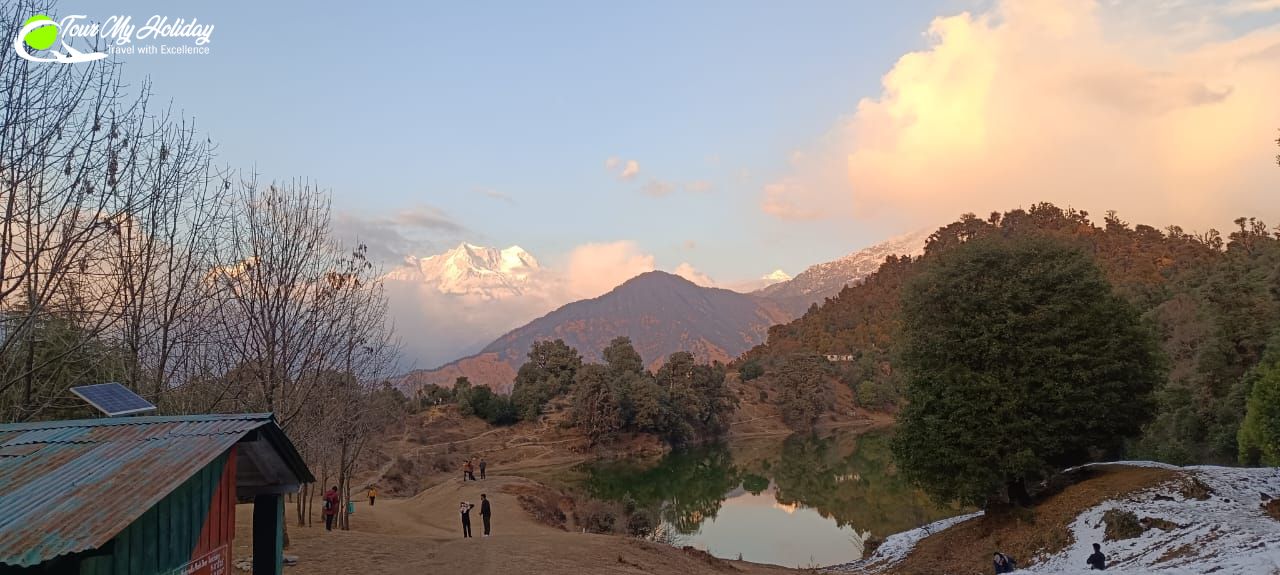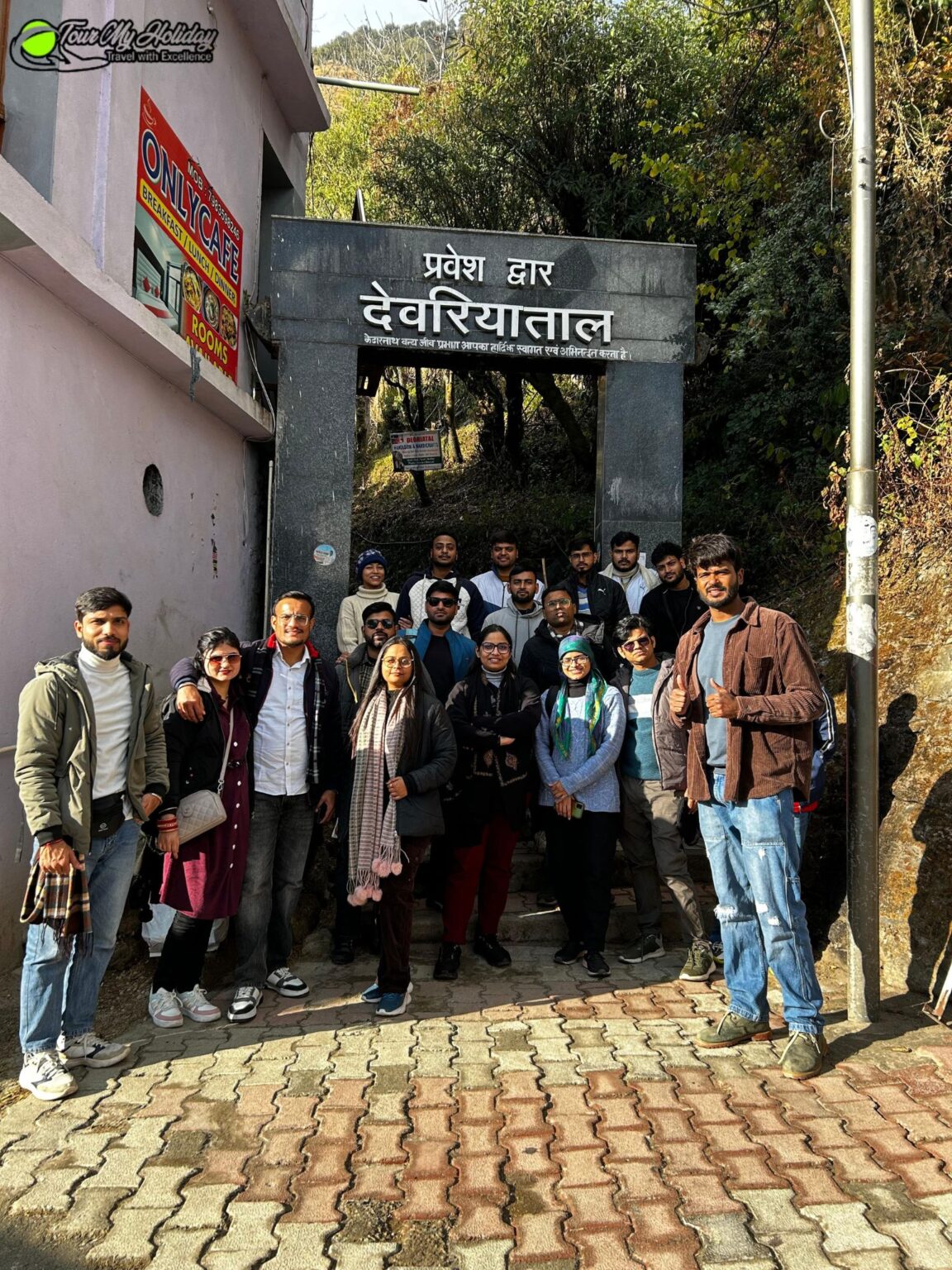Deoriatal Lake
Published on October 24, 2024
Deoria Tal – The Enchanted Lake of Reflections
Tucked away in the Garhwal Himalayas at an altitude of about 2,438 meters, Deoria Tal is a pristine, emerald-green lake surrounded by dense forests of rhododendron, oak, and deodar. The lake is famed for its mirror-like reflections of the Chaukhamba peaks, creating postcard-perfect views that seem almost unreal.
Deoria Tal isn’t just a scenic getaway — it’s a place where myths breathe, birds sing in crystal-clear air, and the still water seems to hold the stories of gods and heroes. Accessible through a short trek, it offers a taste of Himalayan magic without the demands of high-altitude expeditions.

The Myth & History – Legends of the Lake
Deoria Tal is steeped in ancient lore and linked to the great Indian epics. Two popular legends surround its origin:
1. The Yaksha Prashna of Mahabharata
Local tradition identifies Deoria Tal as the very lake where the Pandavas, during their exile, encountered a mysterious Yaksha (a celestial being). When the Pandavas came here in search of water, the Yaksha challenged them with riddles, allowing only Yudhishthira, the eldest, to answer correctly. His wisdom saved his brothers and turned the lake into a symbol of humility, knowledge, and truth.
2. Abode of the Gods
Some locals believe the lake was visited by the Devas (gods) themselves, giving it the name Deoria Tal — meaning “Lake of the Gods.” Its untouched surroundings and divine serenity are often taken as proof of its sacred origins.
The Trek – Gateway to Serenity
The most popular route to Deoria Tal starts from Sari village, about 12 km from Ukhimath. The trek is short and relatively easy, making it perfect for beginners and families.
Quick Facts:
- Starting Point: Sari Village (~2,000 m)
- Lake Altitude: 2,438 m
- Trek Distance: ~2.5 km (one way)
- Duration: 1–1.5 hours ascent, ~1 hour descent
- Difficulty: Easy
- Best Seasons: March–May, July–September (lush monsoon charm), October–December

Route Overview
- Sari to Midpoint
The trail begins with a stone-paved path winding through terraced fields and small village houses. You’ll pass under canopies of oak and rhododendron, with occasional glimpses of the Chaukhamba massif. - Midpoint to Lake
The climb becomes slightly steeper before easing out as you enter a thick forest. Soon, the path opens to a grassy clearing where the emerald waters of Deoria Tal suddenly appear, framed by snow peaks and sky.
The Lake Experience – Mirror of the Mountains
On a clear morning, the surface of Deoria Tal acts like a flawless mirror, reflecting the mighty Chaukhamba peaks with startling clarity. As the sun rises, golden light spills across the water, and the forests come alive with bird calls.
The air here feels purer, the silence deeper. Whether you sit by the shore with a book, meditate under a tree, or capture photographs, the lake’s stillness becomes part of you.
Spiritual Importance
For many, Deoria Tal is not just about beauty but also spiritual connection. Its association with the Mahabharata gives it a sacred aura, and locals treat the lake with deep respect. Sitting by its banks at sunrise or sunset, it’s easy to understand why it is seen as a place of divine presence and self-reflection.
Flora & Fauna
The lake lies in the buffer zone of the Kedarnath Wildlife Sanctuary, making it a haven for nature enthusiasts:
- Flora: Rhododendrons, Himalayan oaks, maple, and wildflowers.
- Fauna: Himalayan monal, hill partridge, foxes, and sometimes musk deer. The lake is also a hotspot for birdwatchers, especially in spring and summer.
Best Time to Visit
- Spring (March–May): Pleasant weather, rhododendrons in bloom, and clear mountain views.
- Monsoon (July–September): The forest turns lush green, the lake brimful, and mist rolls in for an almost fairy-tale atmosphere. Trails can be damp but add to the magic.
- Autumn (October–November): Crystal-clear rflections and golden-hued forests.
- Winter (December–February): Snow around the lake and frozen edges create a serene white wonderland.
Travel Tips
- Early Start: For the best reflections, arrive at the lake early in the morning before winds ripple the surface.
- Stay Hydrated: Carry your own drinking water; there are limited facilities at the top.
- Overnight Camping: Allowed with permission from the forest department — nights under a star-filled Himalayan sky are unforgettable.
- Footwear: Even though the trail is short, wear good trekking shoes, especially in monsoon and winter.
- Responsible Travel: Do not litter; carry all waste back down. The lake’s purity depends on visitor care.

Accommodation Options
- Sari Village: Offers budget guesthouses and homestays with warm local hospitality.
- Camping at Deoria Tal: For a deeper experience, pitch tents near the lake with prior permits.
How to Reach Sari Village
- By Road: Well-connected from Rishikesh, Haridwar, and Dehradun (approx. 200–250 km).
- By Train: Nearest station – Rishikesh (200 km).
- By Air: Nearest airport – Jolly Grant Airport, Dehradun (225 km).
Safety Considerations
- The trail is well-marked, but avoid trekking in the dark.
- In winter, snow can cover the path; walk carefully to avoid slipping.
- Carry a light jacket even in summer — weather changes quickly in the hills.
Nearby Attractions
- Chopta Meadows: Just 20 km away, offering beautiful alpine views.
- Tungnath & Chandrashila: Can be combined with Deoria Tal for a 2–3 day trek circuit.
- Ukhimath: Winter seat of Kedarnath and Madhyamaheshwar deities.
- Kedarnath Wildlife Sanctuary: A biodiversity hotspot for nature walks and photography.

Why Deoria Tal is Unforgettable
Deoria Tal is more than just a lake — it’s a Himalayan mood. In its still waters, you’ll see not only the mountains but also a reflection of your own quiet moments. The place asks for nothing but your presence and offers, in return, an experience of pure stillness and beauty.
Here, the breeze carries stories, the water holds memories, and time slows to the rhythm of the mountains.
